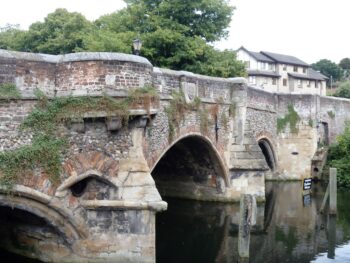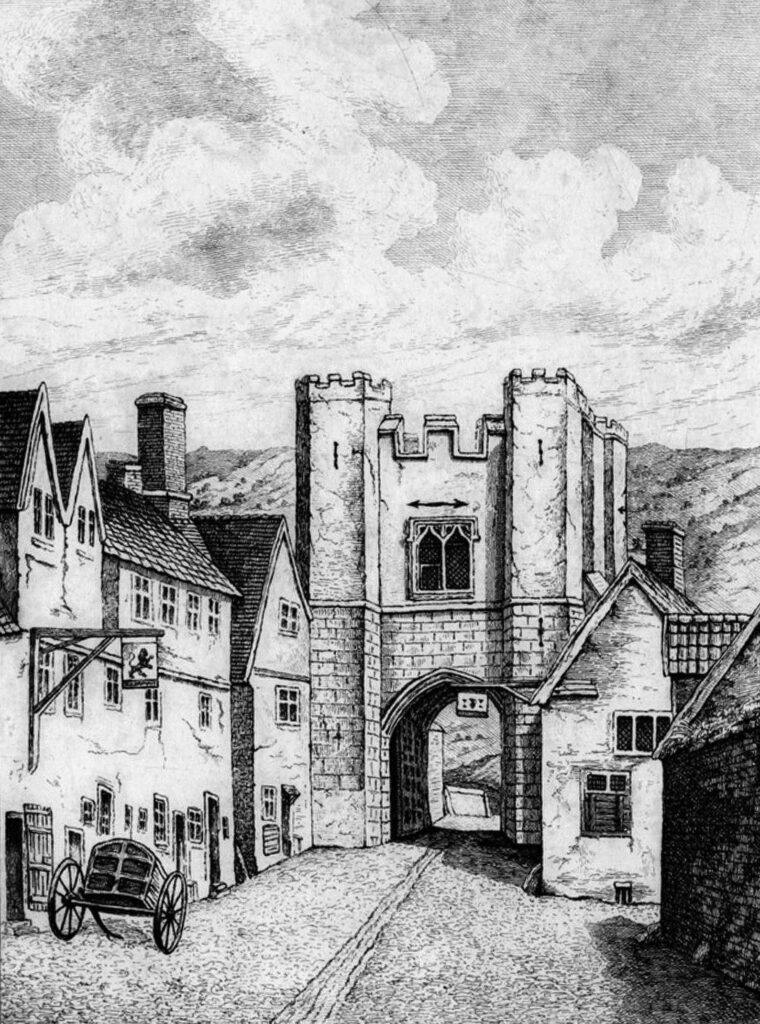
Bishop’s Bridge was a medieval fortified bridge, guarding the entrance to the palace of the Bishop of Norwich, probably dating from around 1340. It had a large gatehouse on one end of the bridge – Bishop’s Gate – with four towers. The gatehouse fell into poor repair and was demolished in 1791. The remainder of the medieval bridge still survives today.
History

In the medieval period, Norwich was perhaps the second largest city in England. Between 1297 and 1350 the city had erected a circuit of defensive stone walls and ditches, both to impress upon outsiders the status of Norwich as a great city, but also to defend against invasion or civil disorder.
Bishop’s Bridge guarded a private access route into the palace of the bishops of Norwich, as well of controlling the river down-stream of the main quays at Whitefriars Bridge. It is unclear when the first bridge on the site was constructed, although William de Kirkby, the Prior of Norwich Cathedral, was given a licence to construct a bridge there in 1275.
The current bridge probably dates from around 1340, when Richard Spynk, a wealthy citizen of Norwich, is recorded as having carried out a wide range of improvements to the city’s walls, including constructing the gatehouse on Bishop’s Bridge, the supporting stone arches of the bridge, and a drawbridge. The east end of the bridge formed that boundary of the city’s jurisdiction, and was later marked with two oak posts.
The city walls did not stretch along this part of the town, which relied on the natural defences of the river, although may have been protective wooden fences, forming a palisade stretching around the river. At the end the 14th century, Cow Tower was constructed just north along the river bend, adding to the local defences.

The gate was maintained by the bishops until 1393, after which control passed to the city, with the Middle-Wymar ward responsible for repairs. In 1460, the gate was manned by a soldier who was responsible for managing access.
In 1549, there was a major revolt across Norfolk by protestors angry at the enclosure of common land. Robert Kett led a large group of rebels to Norwich where they attacked the city on 22 July. The gatehouse on the bridge had been reinforced with banks of earth, but the rebels deployed gunpowder weapons and forced entrance. After the suppression of Kett’s Rebellion, Bishop’s Bridge was repaired, partially using timber taken from nearby White Friars Bridge.
In the early 18th-century, the gatehouse had four octagonal turrets, the front two resting on corbels, with high walls on either side reaching out onto the bridge, forming a barbican. But by 1790, the bridge was in poor repair. A survey showed that the gateway, despite having been repaired with iron anchor plates, was leaning to the north and the underlying bridge was collapsing under its weight. The 9ft (2.75 m) narrow gateway was also too limited to allow traffic and trade to enter the city. In response, the next year the gate-keeper was evicted, the gatehouse was demolished and the bridge repaired, at a total cost of £170.
Bishop’s Bridge still survives today, protected under UK law as a Grade II* Listed Building and as a Scheduled Monument, but only used by foot traffic. The corbels that once supported the gatehouse can be clearly seen, as can the carved crest of the town in the centre of the bridge.
Attribution
The text of this page is licensed under under CC BY-NC 2.0. Photographs on this page include those from the Geograph website, attributed as follows: Bishop’s Bridge, author Michael Dibbs, released under CC BY-SA 2.0.
